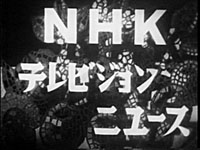|
Moving pictures
in the living room
At 2:00 p.m. on February 1, 1953, the first
television signal was transmitted in Japan. Speaking from the No. 1
studio at NHK's old headquarters in Tokyo's Uchisaiwaicho district,
NHK president Furukaki Tetsuro said: "Television is called a barometer
of culture. In that it will appeal to the eyes and ears of people across
Japan, TV is sure to exert a revolutionary influence on all our lives."
Sure enough, television began to bring major changes to a broad range
of activities: politics, economics, social and cultural affairs —indeed,
to every aspect of life.
Just five cameras
TV broadcasting began in earnest with just
three studio cameras and two for outdoor relays. TV programs were broadcast
live except for some news items and movies shot on film.
Sports, drama and major events
Since there were still no recording devices,
programming centered on live transmissions of sports events such as
baseball games, Grand Sumo tournaments, stage performances, and other
major events. Worthy of special mention is the first live relay of the
All-Japan High School Baseball Championship Tournament at the Koshien
ballpark in August 1953. Thanks to the installation of new micro-circuits,
an event taking place in the Kansai region of western Japan could be
shown for the first time even to viewers in Tokyo and Nagoya. People
were able to view a sporting event in real time without leaving their
living room or paying for admission. Television had arrived—and the
nation was enthralled.
|
|

3:00 p.m., Feb 1, 1953
Japan's first newscast using moving pictures |
Piecing together the TV news
In the early days, television stations were
inadequately equipped to present news in moving images, except in the
form of weekly news digests shot on film. There were regular twice-daily
newscasts lasting a combined total of nine minutes: one, at 12:50 p.m.,
was broadcast for four minutes; the other, a five-minute bulletin, appeared
at 7:20 p.m. To begin with, handwritten news titles were presented on
camera, accompanied by the simple reading out of a modified version
of the radio news. But strong public expectations prompted NHK to make
rapid progress in preparing its own news coverage on film.
| FEBRUARY
1, 1953 |
|
2:00 p.m.
3:00 p.m.
3:30 p.m.
6:30 p.m.
7:00 p.m.
7:15 p.m.
7:20 p.m.
7:25 p.m.
7:30 p.m.
8:00 p.m.
8:15 p.m.
8:45 p.m.
9:00 p.m.
|
The
Tokyo Television Opening Ceremony
Speech by Furukaki Tetsuro
Kabuki relay: Michiyuki
Hatsunenotabi performed by Baiko, Shoroku,
etc.
NHK Television News
Inauguration of the U.S. President
Opera Talk
Intermission (4:00 – 6:30 p.m.)
Children's Hour (singing, variety
show, etc.)
Ten Ten Television
Television Newsreel
Weather Forecast
News
Program Preview
This Week's Star (live from Hibiya
Public Hall)
Comic dialogue
Modern Dance: Japanese Drums
(live from Hibiya Public Hall)
A Message to Viewers: Yano Ichiro
The Birth of Television
End of transmissions |
|


